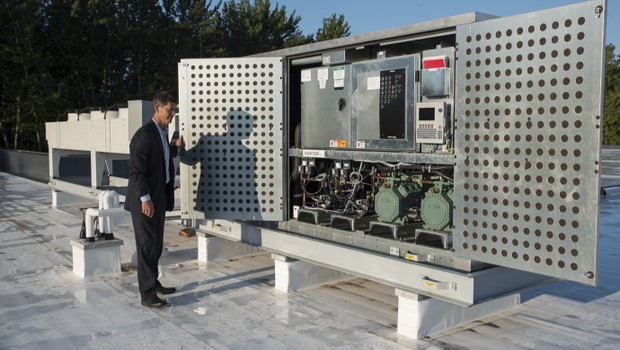ALDI US continues transcritical CO2 rollout

ALDI US, the leading supermarket user of transcritical CO2 refrigeration systems in the U.S., had more than 100 stores using the systems as of early December 2017, according to a webinar hosted by the U.S. Environmental Protection Agency’s GreenChill Partnership.
The December 5 webinar, “Supermarket Experiences Managing Refrigeration Systems in Small-Format Stores,” was presented by Derek Gosselin, director, technical product support for Conyers, Ga.-based Hillphoenix, the primary provider of ALDI’s transcritical systems.
Gosselin also said that ALDI US’s transcritical installations included 60+ transcritical stores in a warm climate (Southern California and the lower third of the U.S.) and 55 GreenChill Platinum-certified stores.
This represents an increase from the 69 ALDI US stores using transcritical technology, and 43 GreenChill Platinum-certified stores, as reported by Accelerate America magazine in its September 2017 issue. Of those 69 stores, 66 were supplied by Hillphoenix (largely the AdvansorFlex unit designed for smaller formats), with the other three stores using systems provided by a partnership between Hussmann and Canadian OEM Systèmes LMP.
ALDI US, with headquarters in Batavia, Ill. – an independently operated member of Mülheim, Germany-based ALDI South (Sud) – runs approximately 1,700 value-oriented supermarkets in the U.S., and plans to expand to 2,500 stores by the end of 2022. The company’s long-term plan is to standardize on transcritical CO2, said Aaron Sumida, an ALDI US vice president quoted in the September Accelerate America article.
Future-proofing
In the webinar, Gosselin gave an overview of the benefits and challenges associated with transcritical CO2 systems.
For example, at a time of regulatory uncertainty at the national and state level, he cited the “future-proof” nature of transcritical CO2, eliminating costs associated with retrofitting. “Now more than ever it’s important to have some type of long-term refrigerant management program that helps you stay out in front of changes on local and national levels,” he said.
Gosselin noted that before ALDI US entered the California market, the company analyzed local regulatory rules enforced by the California Air Resources Board (CARB), and formulate its refrigeration management plan accordingly.
CARB’s proposed Short Lived Climate Pollutants (SLCP) reduction strategy includes a phase-down of high-GWP HFC refrigerants, leading ALDI US to choose CO2 as its refrigerant of choice, he added.
Gosselin also listed the well-known benefits of CO2 – that it has a GWP of one and an ODP of zero; it’s non-toxic, and non-flammable and has no charge restrictions. In addition, CO2 offers cost savings on refrigerant charge, electrical and piping installation, case performance and energy consumption, he said.
He noted that electronic expansion valves (EEVs) – required in cases refrigerated by transcritical systems – modulate the inlet-to-outlet temperatures in evaporators to constantly optimize the evaporator superheat, said Gosselin. With mechanical valves, he added, superheat is rarely optimal and should be seasonally adjusted per manufacturer recommendations – which, in practice, never occurs. EEVs also prevent case temperatures from fluctuating, which benefits the quality and shelf life of food products.
Other intangible benefits include relief from leak and recordkeeping requirements, maintaining better quality products with case controls, savings from preventive maintenance and positively impacting the environment.
For ALDI, the decision to install Hillphoenix’s compact AdvansorFlex CO2 booster system in its small-format stores was also born from the flexibility of such systems.
“The AdvansorFlex compact CO2 booster system provides them with the flexibility of either an indoor or an outdoor location – depending on site restrictions,” Gosselin said. “It also allows them to adapt to an air-cooled gas cooler for cooler climates as well as adiabatic for warmer climates that will improve the performance of the system.”
Some of the challenges associated with CO2 systems include providing training on installation start-up and maintenance to contractors not versed in the technology. Transcritical systems may also utilize adiabatic condensers and parallel compression to maintain energy efficiency in warmer climates, he noted.
The equipment cost of CO2-based systems is still higher than most traditional systems, ranging from 10% to 50%, Gosselin said. But that cost is starting to come down as the technology becomes more widely adopted – with uptake being driven by retailers like ALDI US. Moreover, compact transcritical systems support a lower first cost, and some utilities – such as the Sacramento Municipal Utility District – offer incentives for installing natural refrigerant systems.
He also pointed out the need to look not only at equipment cost, but installed cost, which reflects the savings on refrigerant and piping, as well as energy and refrigerant savings over time. This can result in a favorable ROI and total cost of ownership.
